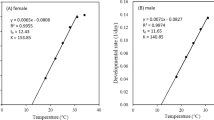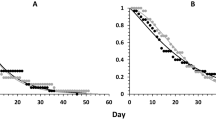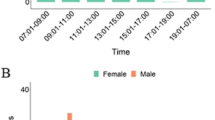Abstract
The reproductive tract of the parasitoidMicroctonus hyperodae was found to comprise 6.1±0.2 ovarioles containing a total of 40–60 oöcytes. After oviposition into its hostListronotus bonariensis, the parasitoid's egg volume increased by 205 times prior to hatching. At 19.1°C ovipositingM. hyperodae survived for a mean 21±4 days and laid a mean of 48±8 eggs.M. hyperodae collected from Colonia, Uruguay laid a mean of 62±15 eggs which was significantly more than the other ecotypes. Under caging conditions with an ample supply of hosts,M. hyperodae laid 51% of its eggs in the first 72 hours and on average 41% of the species' life-span occurred after the exhaustion of its egg supply. Minimum temperature forM. hyperodae oviposition was found to be c. 5°C; beyond this the rate of increase in egg-laying was approximately linear until 30°C whereafter the rate fell abruptly. There was effectively no egg-laying at 39°C. The parasitoid showed no preference for one host sex or the other either in the laboratory or under field conditions. Compared to otherMicroctonus spp.,M. hyperodae appeared to show low fecundity and high longevity. The adaptive implications of this are discussed.
Résumé
Le système reproducteur du parasitoïdeMicroctonus hyperodae est composé de 6.1±0,2 ovarioles qui contiennent de 40 à 60 ovocytes. Entre la ponte dans l'hôteListronotus bonariensis et l'éclosion, le volume de l'œuf du parasitoïde est multiplié par 205. A 19,1°C, la longévitéM. hyperodae en présence d'hôtes est en moyenne de 21±4 jours et la fécondité moyenne de 48±8 œufs. Une souche deM. hyperodae récoltée en Colonie, Uruguay, a présenté une fécondité moyenne de 62±15 œufs, significativement supérieure à celle des autres souches. En cage et en présence d'une importante quantité d'hôtes,M. hyperodae pond 51% de ses œufs au cours des premières 72 heures et en moyenne 41% de la durée de vie de l'espèce a lieu après l'épuisement de sa réserve d'œufs. La température minimale pour l'oviposition deM. hyperodae est de 5°C. Au-delà de ce seuil, le taux d'accroissement du nombre d'œufs pondus est approximativement linéaire jusqu'à 30°C puis ce taux baisse soudainement. A 39°C, il n'y a presque plus de ponte. Le parasitoïde ne montre pas de préférence entre les hôtes mâles et femelles, ni au laboratoire ni en conditions de terrain. En comparaison avec d'autresMicroctonus spp.,M. hyperodae paraît avoir une fécondité basse et une longévité élevée. Les implications adaptives sont examinées.
Similar content being viewed by others
References
Barker, G. M., Pottinger, R. P. &Addison, P. J. — 1989. Population dynamics of the Argentine stem weevil (Listronotus bonariensis) in pastures of Waikato, New Zealand. —Agric. Ecosyst. & Environ., 26, 79–115.
Barker, G. M. &Goh, H. H. — 1993. Interactions between the parasitoidMicroctonus hyperodae and the pathogenBeauveria bassiana in the Argentine stem weevil,Listronotus bonariensis. In:Pest Control & Sustainable Agriculture.S. A. Corey, D. J. Dall &W. M. Milne (eds.). —CSIRO Information Services, Australia, 272–274.
Barlow, N. D., Goldson, S. L., McNeill, M. R. & Proffitt, J. R. — 1993. Measurement of the attack behaviour ofMicroctonus hyperodae as a classical biological control agent of Argentine stem weevilListronotus bonariensis. —Proc. 6 th Australas. Conf. Grassland Invert. Ecol., 326–330.
Barlow, N. D., Goldson, S. L. &McNeill, M. R. — 1994. A prospective model for the phenology ofMicroctonus hyperodae (Hymenoptera: Braconidae), a potential biological control agent of Argentine stem weevil in New Zealand. —Biocontrol Science and Technology, 4, 375–386.
Bender, J. C. — 1943. Anatomy and histology of the female reproductive organs ofHabrobracon juglandis (Ashmead) (Hymenoptera: Braconidae). —Ann. Entom. Soc. Am., 36, 537–545.
Blair, I. D. & Morrison, L. — 1949. Wheat diseases & insect pests. —Department of Scientific and Industrial Research, Wellington, New Zealand, Information Series, 3, 59 p.
Drea, J. J., Dysart, R. J., Coles, L. W. &Loan, C. C. — 1972.Microctonus stelleri (Hymenoptera: Braconidae, Euphorinae), a new parasite of the alfalfa weevil introduced into the United States. —Can. Ent., 104, 1445–1456.
Edson, K. M. &Vinson, S. B. — 1979. A comparative morphology of the venom apparatus of female braconids (Hymenoptera: Braconidae). —Can. Ent., 111, 1013–1024.
Flanders, S. E. — 1942. Oösorption and ovulation in relation to oviposition in the parasitic Hymenoptera. —Ann. Entom. Soc. Am., 35, 251–266.
Flanders, S. E. — 1950. Regulation of ovulation and egg disposal in the parasitic Hymenoptera. —Can. Ent., 82, 134–140.
Frakes, R. V. — 1973. The ryegrasses. In: Forages. The Science of Grassland Agriculture. (M. E. Heath, D. S. Metcalfe &R. E. Barnes (eds)). —Iowa State University Press, Iowa, 307–313.
Fusco, R. A. &Hower, Jr. A. A. — 1973. Host influence on the laboratory production of the parasitoid,Microctonus aethiops (Nees). —Environ. Entomol., 2, 971–975.
Fusco, R. A. &Hower, Jr. A. A. — 1974. Influence of parasitoid-host density and host availability on the laboratory propagation ofMicroctonus aethiops [Hym.: Braconidae] parasitoid ofHypera postica [Coleop.: Curculionidae]. —Entomophaga, 19, 75–83.
Godfray, H. C. J. — 1994. Parasitoids: Behavioral and Evolutionary Ecology. —Princeton University Press, Princeton, New Jersey (USA), 473 p.
Goldson, S. L. — 1981. Non-reproductive determination of “migratory” flight in Argentine stem weevils,Listronotus bonariensis. —Physiol. Entomol., 6, 283–288.
Goldson, S. L., Barker, G. M., Barratt, B. I. P. &Barlow, N. D. — 1994. Progress in the biological control of Argentine stem weevil and comment on its potential. —Proc. NZ Grassld Ass., 56, 39–42.
Goldson, S. L. &Emberson, R. M. — 1981. Reproductive morphology of the Argentine stem weevilHyperodes bonariensis (Coleoptera: Curculionidae). —NZ J. Zool., 8, 67–77.
Goldson, S. L. & McNeill, M. R. — 1992. Variation in the critical photoperiod for diapause induction inMicroctonus hyperodae, a parasitoid of Argentine stem weevil. —Proc. 45 th NZ Plant Prot. Conf., 205–209.
Goldson, S. L., McNeill, M. R., Phillips, C. B. &Proffitt, J. R. — 1992. Host specificity testing and suitability of the parasitoidMicroctonus hyperodae.(Hym.: Braconidae, Euphorinae) as a biological control agent ofListronotus bonariensis (Col.: Curculionidae) in New Zealand. —Entomophaga, 37, 483–498.
Goldson, S. L., McNeill, M. R. & Proffitt, J. R. — 1993a. Unexplained mortality amongst unparasitisedListronotus bonariensis in the presence of the parasitoidMicroctonus hyperodae under caging conditions. —Proc. 6 th Australas. Conf Grassland Invert. Ecol., 355–362.
Goldson, S. L., McNeill, M. R. &Proffitt, J. R. — 1993b. Effect of host condition on the development ofMicroctonus hyperodae Loan, a parasitoid of the Argentine stem weevil (Listronotus bonariensis) (Kuschel). —NZ J. Zool., 20, 89–94.
Goldson, S. L., McNeill, M. R., Proffitt, J. R., Barker, G. M., Addison, P. J., Barratt, B. I. P. &Ferguson, C. M. — 1993c. Systematic mass rearing and release ofMicroctonus hyperodae (Hym.: Braconidae, Euphorinae), a parasitoid of the Argentine stem weevilListronotus bonariensis (Col.: Curculionidae) and records of its establishment in New Zealand. —Entomophaga, 38, 527–536.
Goldson, S. L., McNeill, M. R., Stufkens, M. W., Proffitt, J. R., Pottinger, R. P. & Farrell, J. A. — 1990. Importation and quarantine ofMicroctonus hyperodae, a South American parasitoid of Argentine stem weevil. —Proc. 43 rd NZ Weed Pest Contr. Conf., 334–338.
Hodgson, D. J., Potter, M. A., Lövei, G. L., McNeill, M. R. & Goldson, S. L. — 1993. The effects of water, glucose and pollen as dietary components on the longevity of adultMicroctonus hyperodae (Hymenoptera: Braconidae, Euphorinae), a parasitoid ofListronotus bonariensis (Coleoptera: Curculionidae). —Proc. 6 th Australas. Conf. Grassland Invert. Ecol., 384–390.
Lloyd, D. C. — 1966. Surveys for natural enemies ofHyperodes bonariensis Kuschel in South America. —Commonwealth Institute of Biological Control, Mimeographed Report, 16 p.
Loan, C. C. — 1963. The bionomics ofSitona scissifrons (Coleoptera: Curculionidae) and its parasiteMicroctonus sitonae (Hymenoptera: Braconidae). —Ann. Entom. Soc. Am., 56, 600–612.
Loan, C. C. &Holdaway, F. G. — 1961.Microctonus aethiops (Nees) auctt. andPerilitus rutilus (Nees) (Hymenoptera: Braconidae), European parasites ofSitona weevils (Coleoptera: Curculionidae). —Can. Ent., 93, 1057–1079.
Loan, C. C. &Lloyd, D. C. — 1974. Description and field biology ofMicroctonus hyperodae Loan, n. sp. [Hymenoptera: Braconidae, Euphorinae] a parasite ofHyperodes bonariensis in South America [Coleoptera: Curculionidae]. —Entomophaga, 19, 7–12.
Luff, M. L. — 1976. The biology ofMicroctonus caudatus (Thomson), a braconid parasite of the ground beetleHarpalus rufipes (Degeer). —Ecol. Entomol., 1, 111–116.
McNeill, M. R., Goldson, S. L. &Baird, D. B. — 1996. Evidence of host discrimination byMicroctonus hyperodae Loan (Hym.: Braconidae, Euphorinae), a parasitoid of the Argentine stem weevilListronotus bonariensis (Kuschel) (Col.: Curculionidae). —Biocont. Sc. Tech., 6, 77–89.
Nealis, V. G. &Fraser, S. — 1988. Rate of development, reproduction, and mass-rearing ofApanteles fumiferanae Vier. (Hymenoptera: Braconidae) under controlled conditions. —Can. Ent., 120, 197–204.
Phillips, C. B. &Baird, D. B. — 1996. A morphometric method to assist in defining the South American origins ofMicroctonus hyperodae Loan (Hymenoptera: Braconidae) established in New Zealand. —Biocont. Sc. Tech., 6, 189–205.
Phillips, C. B., Baird, D. B. & Goldson, S. L. — 1994. The South American origins of New ZealandMicroctonus hyperodae parasitoids as indicated by morphometric analysis. —Proc. 47 th NZ Plant Prot. Conf., 220–226.
Pottinger, R. P. — 1966. Observations on the flight activity of stem weevilHyperodes bonariensis Kuschel in Canterbury, New Zealand. —Proc. 19 th NZ Weed Pest Contr. Conf., 186–196.
Prestidge, R. A., Barker, G. M. & Pottinger, R. P. — 1991. The economic cost of Argentine stem weevil in pastures in New Zealand. —Proc. 44 th NZ Weed Pest Contr. Conf., 165–170.
Proffitt, J. R., Ferguson, C. M., McNeill, M. R., Goldson, S. L., Macnab, H. R. & Barratt, B. I. P. — 1993. A comparison of sampling methods for adultListronotus bonariensis (Kuschel). —Proc. 6 th Australas. Conf. Grassland Invert. Ecol., 67–72.
Price, P. W. — 1975. Reproductive strategies of parasitoids. In: Evolutionary Strategies of Parasitic Insects and Mites. (P. W. Price ed.). —Plenum Press, New York, 87–111.
Price, P. W. — 1991. Evolutionary theory of host and parasitoid interactions. —Biological Control, 1, 83–93.
Saville, D. J. — 1990. Multiple comparison procedures: the practical solution. —Am. Stat., 44, 174–180.
Smith, O. J. — 1952. Biology and behaviour ofMicroctonus vittatae Muesebeck (Braconidae) with description of its immature stages. —University of California Publications in Entomology, 9, 315–343.
Williams, C. L., Goldson, S. L., Baird, D. B. &Bullock, D. W. — 1994. Geographical origin of an introduced insect pest,Listronotus bonariensis (Kuschel), determined by RAPD analysis. —Heredity, 72, 412–419.
Author information
Authors and Affiliations
Rights and permissions
About this article
Cite this article
Goldson, S.L., McNeill, M.R., Proffitt, J.R. et al. An investigation into the reproductive characteristics ofMicroctonus hyperodae (Hym.: braconidae), a parasitoid ofListronotus bonariensis (Col.: Curculionidae) . Entomophaga 40, 413–426 (1995). https://doi.org/10.1007/BF02373729
Received:
Accepted:
Issue Date:
DOI: https://doi.org/10.1007/BF02373729




